Jai Gurudev Sadh Sangat!

Vodpod videos no longer available.
| Guru | Shri Guru Ravidass Maharaj Ji |
| Religion | Ravidassia Sikh |
| Holy Book | Amritbani / Shri Guru Granth Sahib |
| Symbol | Har |
| Salutation | Jai Gurudev |
| Pilgrimage | Shri Guru Ravidass Janam Asthan Mandir Seer Goverdhanpur Varanasi (U.P.) India. |
| Objectives | To propagate the Bani and teachings of Satguru Ravidass Ji. The teachings and thought of Maharishi Bhagwan Balmiki Ji, Satguru Namdev Ji, Satguru Kabir Ji, Satguru Trilochan Ji, Satguru Sain Ji and Satguru Sadna Ji would also be propagated. To respect all religions, love the mankind and lead virtuous life. |
Ravidassia (Punjabi: ਰਬਿਦਾਸੀ or ਆਦ ਧਰਮ ) is a tradition[1] based on the teachings of Shri Guru Ravidass Ji, who is considered the Satguru.
Ravidassia tradition itself is not a part of Sikhism but are part of the larger Sikh ethnic group[citation needed], other teachings of Shri Guru Ravidass Ji are part of the holy Sikh scriptures, the Guru Granth Sahib.
In 14th century India, Shri Guru Ravidass Ji, a Dalit by birth, taught spirituality and tried to bring forward the equality message of Guru Nanak Dev based on emancipation from the oppression of the Indian caste system. He was born in an oppressed community known as Chamars, who were considered “untouchable”.
Shri Guru Ravidass Ji attracted the lowest strata of Hindu society according to the caste system.
A member of the Ravidassia sect is called a “Ravidassia”.
The Ravidassi religious symbol is known as the Nishaan, distinct from the Sikh Nishan Sahib. Strictly speaking “Nishaan” means “symbol” and is used in Ravidasi context to mean their mantras passed down by their Sants. There is some discussion going on among some Ravidassias that the symbol should be Sohang or Har.
February 25, 2010 | Categories: Information | Tags: Ad Dharmi, Amritbani, Asia, Caste, Chamar, Dalit, God, Gurdwara, Guru Granth Sahib, Guru Nanak Dev, Guru Ravidass, Gurudwara, Har, Hari, Haryana, Himachal Pradesh, Hindu, Hinduism, Human, India, Indian, Jai Gurudev, Mira Bhai, Nagar Kirtan, Nishaan, Nishan Sahib, Parade, Pilgrimage, Place of worship, Punjabi, Rajasthan, Ravidas, Ravidasi, Ravidassia, Ravidassia Community, Religion and Spirituality, Shri Guru Ravidass Ji, Shudra, Sikh, Sikhism, Sri Guru Granth Sahib, Uttar Pradesh, Varanasi, village | 11 Comments
Shri Guru Ravidass Ji
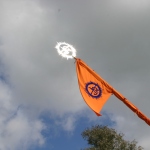
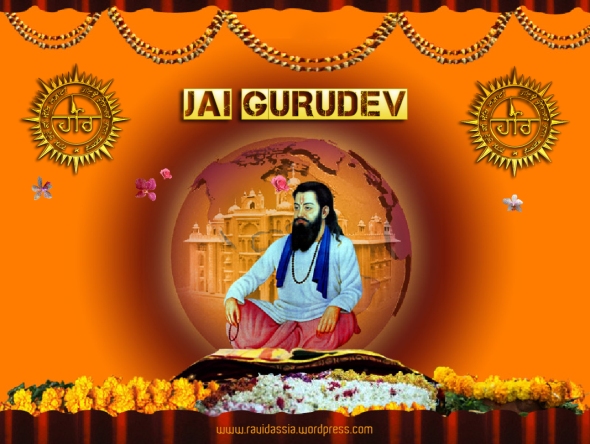 Shri Guru Ravidass Ji is the founder of the Ravidassi faith by his followers. Satguru Ravidass has become a very popular Guru in the Ad dharmi/Ravidassia community. Bangaru Laxman (Bharatiya Janata Party (BJP) Scheduled Caste Morcha president) accused the slandering of Hinduism for treatment of backward castes as a “disrespect to [Dalit] saints like Satguru Ravidas, Satyakam Jabali, Sadhna Kasai, Banka Mahar, Dhanna Chamar and others who protected Hindus against foreign onslaughts.”[3]
Shri Guru Ravidass Ji is the founder of the Ravidassi faith by his followers. Satguru Ravidass has become a very popular Guru in the Ad dharmi/Ravidassia community. Bangaru Laxman (Bharatiya Janata Party (BJP) Scheduled Caste Morcha president) accused the slandering of Hinduism for treatment of backward castes as a “disrespect to [Dalit] saints like Satguru Ravidas, Satyakam Jabali, Sadhna Kasai, Banka Mahar, Dhanna Chamar and others who protected Hindus against foreign onslaughts.”[3]
His hymns are recorded in the Guru Granth Sahib, a quotation being: “My caste is low, my lineage is low, and mean is my birth. I have sought God’s refuge, says Ravidas the cobbler.”[4]
Shri Guru Ravidass Ji was also the guru of the Vaishnava Sant Mira Bai.
February 14, 2010 | Categories: Information | Tags: Ad Dharmi, Amritbani, Asia, Bangaru Laxman, Bharatiya Janata Party, Caste, Chamar, Dalit, God, Gurdwara, Guru Granth Sahib, Guru Ravidass, Gurudwara, Har, Hari, Haryana, Hindu, Hinduism, Human, India, Indian, Jai Gurudev, Mira Bhai, Nagar Kiirtan, Nagar Kirtan, Nishaan, Nishan Sahib, Parade, Pilgrimage, Place of worship, Punjabi, Ravidas, Ravidasi, Ravidassia, Ravidassia Community, Religion and Spirituality, Shri Guru Ravidass Ji, Shudra, Sikh, Sikhism, Sohang, Soul, Sri Guru Granth Sahib, Uttar Pradesh, Varanasi, village | 14 Comments
Chamars

Chamars in the Punjab
The most politically and socially influential Chamars are from the state of Punjab (India), where they form 11% of the population with Dalits comprising 27% of the population. In the Punjab they are divided into various groups, such as ”Ad-Dharm” and ”Ravidassia”. In Majha area they share the same Gotras as Saraswati and Mohyal Brahmins, in Doaba and Malwa area they share family names with Jats and Rajputs. Where as in Malwa most of the Chamars turned to Sikhism . In Majha they are being called Ravidasia, in Doaba they are being called Adi -Dharmi . They are highly concentrated in the Doaba of Punjab. In Malwa Region Chamars have a faith in Sikhisim.
Chamars in Rajasthan
Chamar denotes profession but nowadays misunderstood with caste.The castes which were involved in leather work in past ( before independence )were termed as Chamar in general.Chamars in Rajasthan can only be identified in the districts adjoining to the states of Punjab, Haryana and Uttar Pradesh. The districts of Bikaner, Shriganganagar,Hanumangarh, Churu, Jhunjhunu, Alwar, Bharatpur and Dhaulpur are inhabited by Chamars..Now a days.Raigar (leather tanners ) and Mochi (Shoe-makers) are other two predominant castes related with leather profession.
Chamars in Uttar Pardesh & Bihar
In U.P. chamars are being called Jatav, Kureels,Dohrey,Dhusia etc. Jatavs are mainly concentrated in the Western part of U.P and also in Delhi and Haryana.Famous freedom fighter Banke Chamarwas also from Village Kurarpur, Dist. Jaunpur ,Uttar Pradesh.This Brave Revolutionary laid down his life for the country and was hanged by britishers for his active role in freedom struggle of 1857.
February 14, 2010 | Categories: Information | Tags: Ad Dharmi, Amritbani, Asia, Caste, Chamar, Dalit, Gurdwara, Guru Ravidass, Gurudwara, Har, Hari, Haryana, Himachal Pradesh, Hindu, Hinduism, Human, India, Indian, Jai Gurudev, Jat people, Mira Bhai, Nagar Kiirtan, Nagar Kirtan, Nishaan, Nishan Sahib, Parade, Pilgrimage, Place of worship, Punjabi, Rajasthan, Ravidas, Ravidasi, Ravidassia, Ravidassia Community, Religion and Spirituality, Shri Guru Ravidass Ji, Shudra, Sikh, Sikhism, Sohang, Soul, Sri Guru Granth Sahib, Uttar Pradesh, Varanasi, village | 11 Comments
Beliefs

Shri Guru Ravidass Ji’s teachings represent an offshoot of the bhakti and Sant Mat movements of the fifteenth century, a religious renaissance in India.
Shri Guru Ravidass Ji taught the following principles:
- The oneness, omnipresence and omnipotence of God, who is called Hari.
- The human soul is a particle of the Divine; the different between the two is like the difference between gold and the ornament, water and the wave.
- The rejection of caste.
- To realize God, which is the ultimate end of human life, man should concentrate on Hari, giving up rituals.
- Birth in a low caste is no hindrance in the way to spiritual development.
- The only way to moksha is to free the mind from duality.
- Pilgrimage and bathing in holy lakes is in vain.
The Shri Guru Ravidass Mission London states that:
- One who preaches the Shri Guru Ravidass Ji philosophy is a Ravidasi.
- It is not a condition that one should have been born in the Ravidasi community to become or initiated as one.
- There is even a holy scripture called Guru Sikhya Sahib mainly his quotations being taken out of the Guru Granth Sahib
- To celebrate Shri Guru Ravidass Jayanti according to the Punjabi calendar, Sunday, Sukhal Falgin Parvithta.
- To meditate on ‘Sohang’ or ‘Har.’
- Whenever any Ravidassia receives, meets, writes or addresses a fellow Ravidassia, he or she should say “Jai Gurudev”.
February 14, 2010 | Categories: Information | Tags: Ad Dharmi, Amritbani, Asia, Caste, Chamar, Dalit, God, Guru Ravidass, Gurudwara, Har, Hari, Haryana, Hinduism, Human, India, Indian, Jai Gurudev, Mira Bhai, Nishaan, Punjabi, Ravidas, Ravidasi, Ravidassia, Ravidassia Community, Religion and Spirituality, Shri Guru Ravidass Ji, Sikhism, Sohang, Soul, Sri Guru Granth Sahib, Uttar Pradesh, village | 6 Comments
Birthplace of Shri Guru Ravidass Ji

According to historians, Shri Guru Ravidass Ji was born on 15 January 1377 and according to the Indian calendar, Sunday Sukhal Falgin Parvithta in 1433. His birthplace is located in the Uttar Pradesh state in India, in the city of Varanasi. The locality was known as Mandhuadhe. The community was known as ‘Kutvandla’, one of the Shudra communities. Shri Guru Ravidass Janam AsthanMandir, at Seer Goverdhanpur, Varanasi, India is the ultimate place of pilgrimage for the followers of Shri Guru Ravidass Ji today
February 14, 2010 | Categories: Information | Tags: Ad Dharmi, Amritbani, Asia, Caste, Chamar, Dalit, God, Guru Ravidass, Gurudwara, Har, Hari, Haryana, Himachal Pradesh, Hindu, Hinduism, India, Indian, Jai Gurudev, Mira Bhai, Nishaan, Pilgrimage, Punjabi, Rajasthan, Ravidas, Ravidassia, Ravidassia Community, Religion and Spirituality, Shri Guru Ravidass Ji, Shudra, Sikhism, Sohang, Soul, Sri Guru Granth Sahib, Uttar Pradesh, Varanasi, village | 7 Comments
Gurdwaras

The Ravidassia place of worship is called a bhawan and is referred to as such by strict orthodox Ravidassias.[5] Technically a Ravidassia can meditate and reflect on God anywhere, as Guru Ravidass stated that “God dwells within the heart and is always around us.” It is not a strict requirement to cover one’s head and to remove footwear when entering a bhawan, but many people do so, due to the influence of Sikhism on the Ravidassia faith. Outside a bhawan there is always a red flag upon which is written the Nishaan, and above it an electric lamp symbolising enlightenment from Shri Guru Ravidass Ji’s teachings. Langar, a communal lunch, takes place inside the bhawan and all are free to partake of it. The Guru Granth Sahib is installed as the focal point in the main worship room, however most features of the center don’t differentiate much to any features of the main Gurdwara
February 14, 2010 | Categories: Information | Tags: Ad Dharmi, Amritbani, Asia, Caste, Chamar, Dalit, God, Gurdwara, Guru Ravidass, Gurudwara, Har, Hari, Haryana, Himachal Pradesh, Hindu, Hinduism, Human, India, Jai Gurudev, Mira Bhai, Nishaan, Pilgrimage, Place of worship, Punjabi, Rajasthan, Ravidas, Ravidasi, Ravidassia, Ravidassia Community, Religion and Spirituality, Shri Guru Ravidass Ji, Shudra, Sikh, Sikhism, Sohang, Soul, Sri Guru Granth Sahib, Uttar Pradesh, Varanasi, village | 4 Comments
Nagar Kirtan
The birthday of Shri Guru Ravidass Ji (Shri Guru Ravidass Jayanti)on February 16 is celebrated every year. It is the annual focal point for Ravidasis. On the day the Amritbani is read, the Nishan Sahib is changed ceremonially, and there is a special arti and aNagar Kirtan procession bearing his portrait are taken out to the accompaniment of music through the streets of the temple locality.
February 14, 2010 | Categories: Information | Tags: Ad Dharmi, Amritbani, Asia, Caste, Chamar, Dalit, God, Gurdwara, Guru Ravidass, Gurudwara, Har, Hari, Haryana, Himachal Pradesh, Hindu, Hinduism, Human, India, Indian, Jai Gurudev, Mira Bhai, Nagar Kiirtan, Nagar Kirtan, Nishaan, Nishan Sahib, Parade, Pilgrimage, Place of worship, Punjabi, Rajasthan, Ravidas, Ravidasi, Ravidassia, Ravidassia Community, Religion and Spirituality, Shri Guru Ravidass Ji, Shudra, Sikhism, Sohang, Soul, Sri Guru Granth Sahib, Uttar Pradesh, Varanasi, village | Leave a comment
Shri Guru Ravidass Gate

Shri 108 Sant Sarwan Dass Charitable Trust (Regd.) U.K. expressed the desire of having a monumental Gate in the memory of Guru Ravidass Ji in Varanasi City at some prominent road leading to the Mandir so as to perpetuate the memory of Guru Ji. This project was again undertaken by Mandir Trust under the chairmanship of Sant Niranjan Dass Ji.The foundation stone of the gate was laid on 25-05-1997 by Sahib Shri Kanshi Ram Ji BSP Supremo in the presence of prominent residents of Varanasi, distinguished persons and senior bureaucrats. Ms. Mayawati was Hon’ble Chief Minister of Uttar Pradesh at that time. The workers worked day and night. Specially skilled stone layers were engaged from Rajasthan for this project. A huge Gate at Lanka Crossing was built in a very short period. It is a matter of great pride for our community that the gate was inaugurated by the then His Excellency, the President of India, Shri K.R. Narayanan on 16-7-1998. Shri Suraj Bhan Hon’ble Governor and Shri Kalyan Singh Hon’ble Chief Minister of Uttar Pradesh and Babu Kanshi Ram were also present. At the time of inauguration of the gate, the President looked happy. Disregarding the security barriers, he came out to the barricades and shook hands with aam aadmi and saints. It was so rare and happy moment. The visitors raised and waved their hand in his honour, applause and gratitude. Large number of Guru Ji’s devotees and saints from Punjab and other states were present on the occasion along with Sant Niranjan dass Ji and Sant Rama Nand Ji. The writer was also fortunate to attend the inauguration ceremony of the gate. After the inauguration of the gate, His Excellency the President visited Shri Guru Ravidass Janam Asthan Mandir, Seer Govardhanpur, Varanasi. At the instance of Chief Guest, Qaumi Shahid Sant Rama Nand Ji narrated the entire story of research of this site and construction of the temple and the problems faced in this regard. The President took tea and snacks with the Hazoor Maharaj Niranjan Dass Ji, Qaumi Shahid Sant Rama Nand Ji, members of Shri Guru Ravidass Janam Asthan Public Charitable Trust and other VIPs. It is an unforgettable day in the history of Guru Ravidass Mission. The names of the trustees of Sant Sarwan Dass Charitable Trust (UK), who contributed for the construction of the gate, have been carved at the gate thereby immortalising their gesture of perpetuating the memory of Satguru Ravidass Ji in the city of his assertion.
January 16, 2010 | Categories: Information | Tags: Ad Dharmi, Amritbani, Asia, Caste, Chamar, Charitable trust, Dalit, Excellency, God, Gurdwara, Guru Ravidass, Gurudwara, Hari, Haryana, Himachal Pradesh, Hindu, Hinduism, Human, India, Jai Gurudev, List of Chief Ministers of Uttar Pradesh, Mira Bhai, Nishaan, Nishan Sahib, Parade, Pilgrimage, Place of worship, Punjabi, Rajasthan, Ravidas, Ravidasi, Ravidassia, Ravidassia Community, Religion & Spirituality, Religion and Spirituality, Sathya Sai Baba, Shirdi Sai Baba, Shri Guru Ravidass Ji, Shudra, Sikh, Sikhism, Soul, Sri, Sri Guru Granth Sahib, Varanasi | 8 Comments


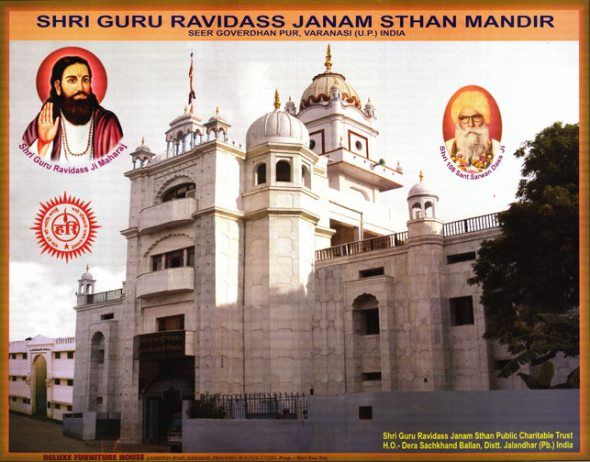
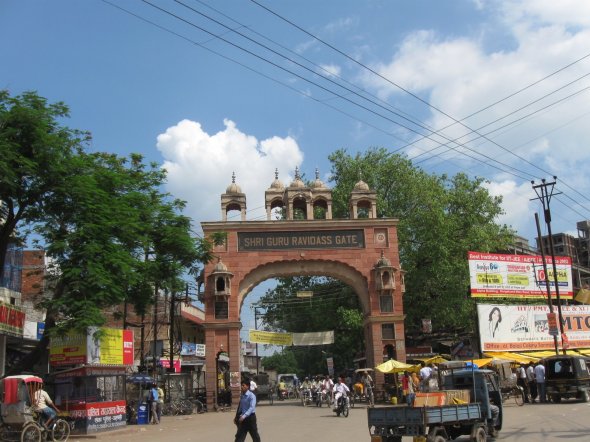
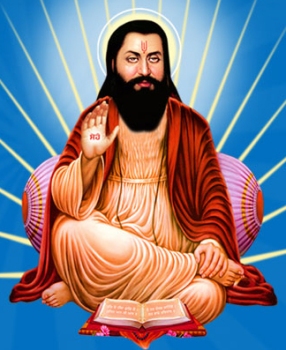


Recent Comments